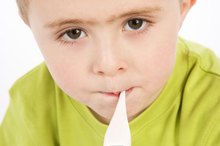High Fever and Racing Resting Pulse for Kids
If you’re a parent, you probably know firsthand how terrifying it is when your child gets a high fever. Add a racing resting pulse to that and you have a recipe for parental panic. Before you rush your child to the emergency room, however, remember that both high fevers and racing resting pulses go hand in hand and are quite normal. Understanding the causes and treatment for both symptoms will help you care for your child and alleviate some of your anxiety.
High Fever
Any temperature over 103.6 degrees Fahrenheit is considered a high fever. While it may seem scary to a parent, a high fever is actually a healthy response to an illness, most commonly caused by a viral or bacterial infection. In the infection-fighting process, your child’s immune system releases substances that raise her body temperature. It’s still important, however, to treat the fever and get it checked out by a doctor to determine the underlying cause. Call your child’s doctor during office hours -- if it’s after hours, call the doctor in the morning 3. Call or page the doctor right away if your child has a fever of 104 F or higher that won’t come down to at least 101 F with treatment.
- Any temperature over 103.6 degrees Fahrenheit is considered a high fever.
- Call or page the doctor right away if your child has a fever of 104 F or higher that won’t come down to at least 101 F with treatment.
Racing Resting Pulse
High Fever Lasting More Than Five Days in Children
Learn More
Accompanied by a fever, a racing or rapid resting pulse is a normal part of the way the body fights infection. A resting heart rate of over 100 beats per minute for children over 10, over 130 bpm for children under 10 and over 120 bpm for infants is considered a rapid pulse. During a fever, the heart beats faster to provide the body organs with the increased oxygen they need. At the same time the body is making an effort to cool itself down, which also contributes to the fast heartbeat. Mention this symptom to the doctor when you take your child to get checked out.
- Accompanied by a fever, a racing or rapid resting pulse is a normal part of the way the body fights infection.
- During a fever, the heart beats faster to provide the body organs with the increased oxygen they need.
Treatment
Treat your child’s high fever with acetaminophen or ibuprofen in order to lower the fever and pulse, and to make your child more comfortable. Give your child acetaminophen every four hours or ibuprofen every six hours. If one medication isn’t effective or wears off quickly, you can overlap the two by alternating them every three hours or so. Use a medication that is formulated for your child’s age and always read and follow the dosage instructions. Never give aspirin to a child younger than 12 years.
- Treat your child’s high fever with acetaminophen or ibuprofen in order to lower the fever and pulse, and to make your child more comfortable.
- Use a medication that is formulated for your child’s age and always read and follow the dosage instructions.
Important Considerations
Normal Pulse Rate of a 17 Month Old
Learn More
Certain symptoms in your child warrant an immediate trip to the emergency room or doctor. If you have an infant who is six weeks old or younger and who has a fever of 101 degrees Fahrenheit or higher, take him to his doctor immediately for an evaluation or to the emergency room if it’s after hours. Confirm the fever with a rectal thermometer first and don’t treat the fever with medication until he has been evaluated. For a child aged 7 weeks to 3 months with a fever under 101 F, an emergency room visit isn’t necessary -- call or page the child’s doctor as soon as possible, however. Symptoms such as:
- lethargy
- irritability
- signs of meningitis -- stiff neck
- vomiting
- headache
- light sensitivity -- also warrant an immediate call or page to the doctor
In addition, a racing resting pulse that is absent of fever should always be checked out by your child’s doctor.
- Certain symptoms in your child warrant an immediate trip to the emergency room or doctor.
- For a child aged 7 weeks to 3 months with a fever under 101 F, an emergency room visit isn’t necessary -- call or page the child’s doctor as soon as possible, however.
Related Articles
References
- AskDrSears.com: Fever
- U.S. National Library of Medicine: Medline Plus: Pulse
- Gunduz S, Usak E, Koksal T, Canbal M. Why Fever Phobia Is Still Common? Iran Red Crescent Med J. 2016;18(8):e23827. doi:10.5812/ircmj.23827
- American Academy of Pediatrics. Fever and Your Baby. Updated August 3, 2016.
- Torreggiani S, Filocamo G, Esposito S. Recurrent Fever in Children. Int J Mol Sci. 2016;17(4):448. doi:10.3390/ijms17040448
- InformedHealth.org. Fever in Children: Overview. Cologne, Germany: Institute for Quality and Efficiency in Health Care (IQWiG); 2013.
- InformedHealth.org. Fever in children: When to see a doctor. Cologne, Germany: Institute for Quality and Efficiency in Health Care (IQWiG); 2009.
- MedlinePlus. When your baby or infant has a fever. Updated February 13, 2020.
- Lim T. Cleveland Clinic. Kids’ Fevers: When to Worry, When to Relax. Published May 12, 2015.
- Murren-Boezem J. The Nemours Foundation. Fevers. Updated September 2018.
Writer Bio
Based in Royal Oak, Mich., Christine Wheatley has been writing professionally since 2009. She contributes to several websites, specializing in articles about fitness, diet and parenting. Wheatley has a Bachelor of Arts in art from Calvin College.








